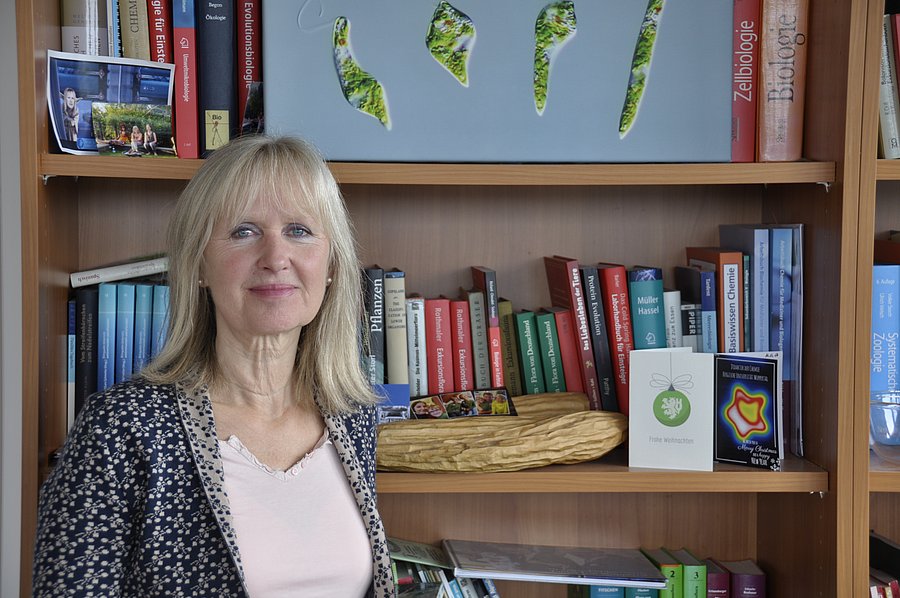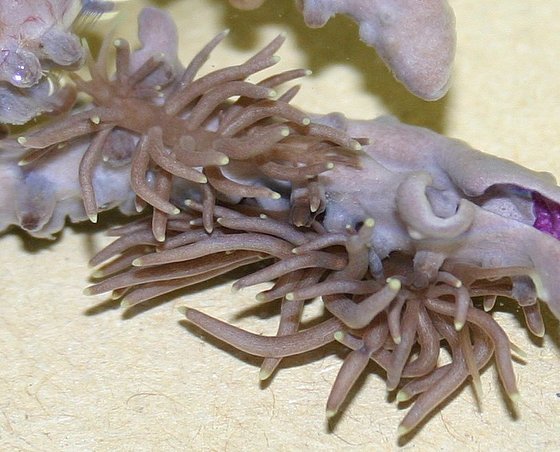
Prof. Dr. Gela Preisfeld / Biology
Photo: UniService Transfer
A very special characteristic of biology is... life
Professor Dr. Gela Preisfeld and the Chair of Biology and Didactics, Zoology at the University of Wuppertal
Albert Einstein once said: "There are only two ways to live. Either as if nothing is a miracle, or as if everything is a miracle." However, there is no clear, generally accepted definition of life in the scientific field. But the work of the Wuppertal biologist Gela Preisfeld at her Chair of Biology and Didactics, Zoology, comes very close to Einstein's miracle.
The scientist and her team are particularly interested in a fascinating area of research, the work with the so-called eye animals (Euglena). For laypersons, these unicellular organisms are actually unspectacular, but they have extraordinary properties. "The Euglena are actually among the first organisms to have developed a real cell nucleus," explains Preisfeld, "but they are also classified in animals and plants. What is exciting about this is the fact that the phagotrophic representatives feed by being able to ingest solid food, i.e. other unicellular organisms or bacteria, through their cell mouth. So far, so good. The researcher says: "You have to keep in mind that these organisms can do with one cell everything we do with several organs. Reproducing, feeding, regulating digestion, all these things take place in one cell. That is fascinating in itself. And at some point in evolution, millions of years ago, it happened that such an organism wanted to eat a green algae, but did not digest it completely, instead enslaving the chloroplasts within itself through a complex process of mutual gene exchange. The undigested part of the algae, i.e. the chloroplasts, were then established as semi-autonomous organelles, which also divide during cell division, so that both daughter cells have their chloroplasts again. Thus, this previous phagotrophic representative was suddenly phototrophic and could carry out photosynthesis. This is known as secondary endosymbiosis". Symbioses are known to drive evolution. Preisfeld and her team are therefore investigating the genome of these chloroplasts to find out what happens in the cell and what traces of these endosymbiosis processes can still be found in this animal-plant being.
How does the marine nudibranchs come to Wuppertal?
The research the chair's owner is conducting on marine nudibranchs that live on corals is similar. Nudibranchs are also called butterflies of the sea because they are so filigree and often beautifully pigmented. Here too, symbioses play an important role in evolution. "Two nudibranchs of the species Phyllodesmium briareum can be seen in Fig. 1, where they are eating corals.

The corals live in a symbiosis with unicellular algae from which they receive photosynthesis products. And, as it is usual in a symbiosis, the algae also have something to gain: a protected environment and minerals that they need for photosynthesis. The snail digests everything from the coral except the algae cells," she explains, "These cells are built into the snail's tissues and even into the cells of the snail, so the snail can survive periods of hunger, since it is "fed" by the photosynthetic products of the algae. But the algae cells are foreign to the snail. Normally the immune components would react to this. But they do not do that and allow it to happen". In various investigations, Preisfeld and her team are trying to find out the reasons for this. She and her team procure the test subjects from the sea via different routes. "On the one hand, we have research cooperations, some of which keep (breed) these animals", she explains, who also breeds at her chair "on the other hand, we also undertake collective trips ourselves". The scientists visit the surrounding aquarium stores, which often receive these snails involuntarily, or dive for the so-called "Verschiedenkiemer" (miscellaneous germs) during their vacations.
The bilingual biology teacher in the age of digitalization
In addition to her research activities, Preisfeld is also significantly involved in the instruction of trainee teachers. She is particularly interested in the concepts of biology, which are oriented towards e.g. energetics or information. In the first step, she raises the students' awareness of these concepts, which in the next step will be transferred to the schools. "They should experience and feel that life is a very special property that cannot be explained by matter (that would be chemistry) and force (that would be physics). It is a property of its own that would not exist without all the other components. There is not a much or a more of life. There is life or there is no life. This is a very special characteristic of biology." In research-oriented, experimental and practical courses, she offers the appropriate access in her subject and says "because by dealing with matter through work in the laboratory, by determining plants and animals that one can really see, touch and smell, i.e. through sensual experiences, one learns much more easily, motivates students and school children much better".
Although she sees digitalization as an added value for teaching, she believes it should be used sensibly, because young children in particular often need an original encounter with the object when it comes to sensory experiences. "I am interested in subject-specific digital knowledge, skills and abilities," she explains and asks questions. "How do I evaluate measurement results? How does a graphic emerge from a machine and what equipment do I need to use to carry out subject-specific research? What happens when I sequence an organism and have 200 million base pairs? How do I deal with such a database or which rights of an ethical and legal nature do I have to observe?"
In this context, language is of particular importance, because technical terms are naturally part of biology. Preisfeld is an advocate of bilingual teaching, which she wants to implement carefully. "One would certainly do well to incorporate technical language into teaching slowly but steadily growing," she says. "This applies to university and school. In bilingual teaching, we research the use of language. We are a research group at our university, and our idea is that by using both languages alternately, bilingual specialist literature can actually be achieved. Bilingual teaching in schools is often monolingual in the foreign language and this is not the goal". In their student laboratories, certain tasks are carried out in English, others in German. "The mixing of the two language concepts happens in the head. And we combine this with an experimental approach because we think that the retention effect is greatest when different areas of the brain are involved. We can also prove this empirically." Although the success is not immediately apparent, in the long term, students who have been taught bilingually have even more memory than students who have been taught monolingually. Preisfeld would like to offer bilingual lessons - which is usually only offered to high achievers - to all children, and says: "We have noticed that, for example, children who are not interested in language at all, who find English 'stupid', come to the topic through experimentation. They then still like to participate and speak English anyway".
Transfer activities for citizens
The dedicated scientist is also well networked outside the university. As vice chairwoman of the Junior University, she actively promotes the youngest students, to whom she attests an intrinsic motivation with regard to biological fields of knowledge. And she has also presented several spectacular exhibitions to interested members of the public. In cooperation with the Botanical Garden Wuppertal, of which she is the chairwoman, she has regularly presented a charming butterfly show since 2010. Close university contacts to Central America made this possible. "We get these great specimens from certified breeding companies, mainly from Costa Rica. It is a very nice example for the interlocking of ecology, environmental protection and economy, because the catching of free-living specimens is strictly forbidden by the species protection convention".
As an expert, the experienced scientist is also on the road in the Bergisch Land. One of her lectures dealt with the pests of many dog owners, which can become similarly dangerous to humans: the ticks. If the temperature is higher than seven degrees for more than seven days, the blood-sucking ectoparasites become active. So it can come to the infestation through the mild winters already in February . "Protecting is difficult," she openly admits "searching is the very best. Black cumin oil for dogs works well, there are also lotions containing black cumin oil for humans". Borreliosis is the greatest danger, she says, which can be observed in North Rhine-Westphalia. "In Bavaria there is already a compulsory registration for Lyme disease. You can mostly notice it by the wandering blush, which is typical for borreliosis, but does not always occur. The disease is not to be trifled with. For biologists it is almost an occupational disease, and we are also fighting for it to be recognized as such. I have many colleagues who suffer from borreliosis. It goes to the joints, the knees or ankles become thick or it goes to the brain and can lead to neurological disorders. So if you are in a tick area, you should not walk there barefoot or with short pants or search yourself thoroughly.
Working with the pandemic
No contribution seems possible without mentioning the effects of the corona pandemic. The Chair of Biology has also had to accept severe limitations. Presence was largely stopped, practical events were rescheduled. The researcher is particularly proud of her 18-strong staff, which has managed to overcome the crisis. One example: In the knowledge of animal shapes, students have to determine exhibits with a book, starting with insects and ending with birds or even skulls. For this, however, one usually needs the animal, which must be viewed from all sides. At this point, one of her colleagues had the idea to join forces with other universities and provide the students with a digital library of three-dimensional photos of the animals. Small groups of four people each were divided into breakout rooms in zoom meetings, which were visited by the teachers for further individual support. The students' feedback was very positive. "But still," says Preisfeld "I miss the person opposite and I think the students miss that too! I would like to get back to normal operations. Digitalization has expanded our teaching and we have opened up new opportunities, which we will certainly be retaining. But we will definitely return to face-to-face teaching as soon as this is possible".
Wonders need closeness after all.
Uwe Blass (Interview on 17.07.2020)
Professor Dr. Gela Preisfeld studied, received her doctorate and habilitation at the University of Bielefeld. After short research stays in Australia and a representation at the Goethe-University Frankfurt/Main, she accepted the call to the Chair of Biology and its Didactics, Zoology at the University of Wuppertal.
